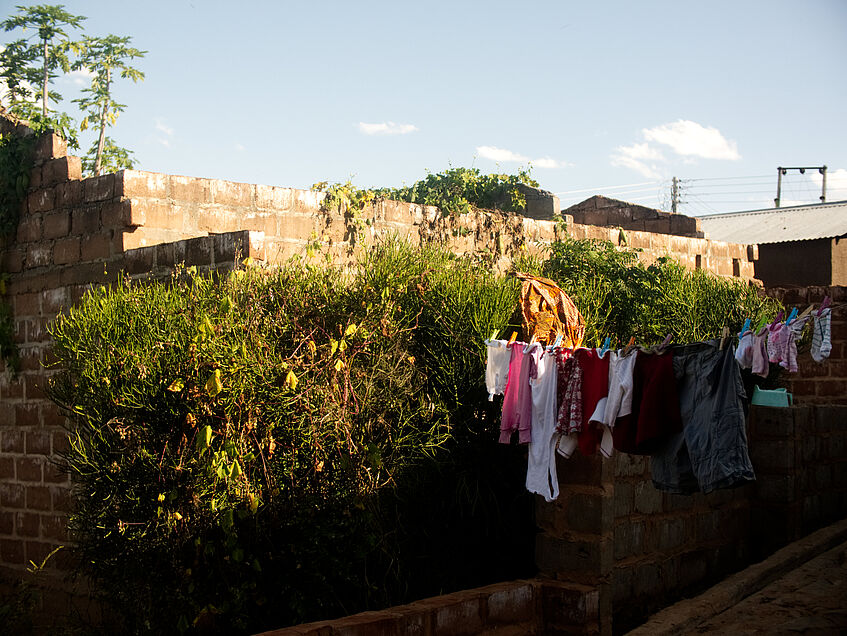A House to be … in Ngwenya

Unfinished house with Euphorbia tirucalli in front. © Carl-Philipp Bodenstein
A House to be … in Ngwenya
Carl-Philipp Bodenstein
Ever since my main informant Jonathan and I have started working together, housing has not only been the topic of my research from a mainly historical perspective, but it was following us on our paths through Livingstone through personal conversations as well. We would talk regularly about the possibilities, struggles, conditions and trends in relation to modern-day urban housing in Livingstone. We would discuss issues about property prices and rent levels, infrastructures, security and life styles. Jonathan would explain who is living where and why. On occasion, after an interview he would add some of his personal insights to what was talked about just before during the interview, creating a bridge between the past and the present. However, his contemplations and notions about what housing means in Livingstone today did not only serve to satisfy my curiosity, but Jonathan had a personal interest in these questions as well.
Living in a rented two-room apartment in the district of Malota which he described as a good place yet insufficient in terms of its size for his wife, two kids and himself, Jonathan often spoke about his plans to build his own house on his own property. When I came back to Livingstone this year his plans had taken on some form as he had bought a property in Ngwenya which he showed me after one of our interviews.
Ngwenya is one of the recent extensions of Livingstone and known for its quarry, a widespread open-pit mine where rocks are extracted and crushed to small pieces for construction works. Other than the high-priced planned extension of Highlands, Ngwenya together with Chibelenga forms a large compound where formal and informal built structures are often indistinguishable from one another. Here, the boundaries of Livingstone are constantly pushed, creating a continuously shifting gradient between formalisation and integration further townwards and informality towards what is referred to as “the bush”. However, while having somewhat of a bad reputation in terms of crime and other social problems, in Ngwenya there are also “good areas” as Jonathan pointed out. Having taken me from Malota to Ngwenya he showed me the border between the “dodgy” and the “nice” part. The latter is bounded by a slope that lies between Highlands and the rest of Ngwenya and Chibelenga. Here he had bought a piece of land.
While walking up the slope Jonathan pointed to the different housing types and changing spatial structures. He explained the difference between this part and the rest of Ngwenya when looking at the pattern in which the properties and houses where laid out, the materials used for construction and the overall arrangement of the more spacious and detached houses and plots. While some variations in size and style exist depending on the means available - some of the often still unfinished houses were equipped with a veranda or a garage and more costly stylistic features like neoclassic pillars - Jonathan stressed the overall consistency within the assemblage.
When we had reached his recently purchased rectangular plot of approximately 20 by 10 meters in size and surrounded by Euphorbia tirucalli (pencil tree) bushes that serve as cheap plot-dividing hedges all over Livingstone as well as other places in Zambia, Jonathan began to elucidate the plans for his future house which he had already finished constructing in his mind. He described in detail where the walls and the front door would be, how the interior space would be divided by the different rooms and how the garden would be arranged with a shaded sitting area in front of a patch with fruits and vegetables. We would inspect meter by meter adding with every step new bits and pieces to the idea of a house yet to be made. For me to have a clearer image we went into one of the unfinished neighbouring houses where he showed me the materials he would use and what he would do in a similar or different way.
Looking at Jonathan, one could not but see the deep dedication to this project that transcends the mere utilitarian notion of being housed and the necessity of having a place to dwell. After silently standing at the edge of the plot for a little while Jonathan said: “Astrida [his wife] is very happy.” He told me that she takes every opportunity to visit the plot with him or by herself just to sit and contemplate on how everything would look like enjoying the idea not only of a physical structure, but rather of how life would be. With Jonathan having worked in South Africa for three years and Astrida constantly moving between Lusaka, where she studies agriculture at University, and Livingstone, where her family lives, the plot and the idea of a house serves as an anchor or as Jonathan put it: “It means future and stability to us.” The idea of their own house cannot be reduced to a necessity of dwelling, an ideology of private property or the economic and social benefits of not being dependent on a landlord. It serves notions of having a place in the world and of belonging, especially at times and in circumstances that are characterised by high levels of contingency and fluidity, where things and people seem to be constantly on the move. The house is then a space to be.
October, 2018
